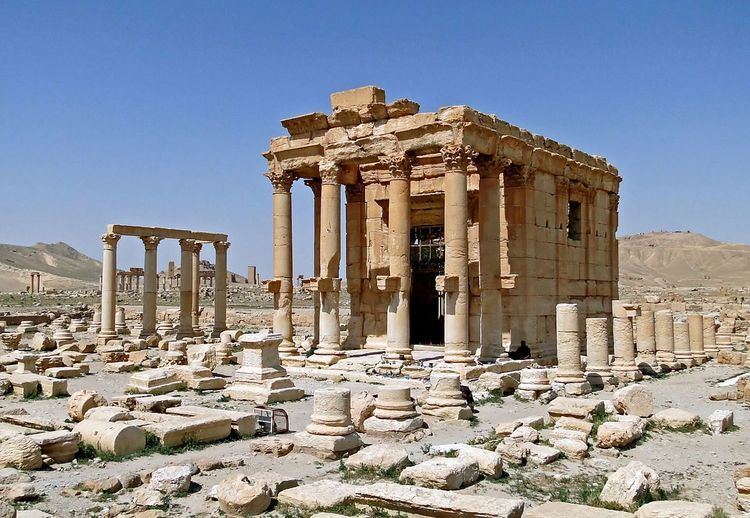Material Stone Cultures Palmyrene | Founded 131 AD Excavation dates 1954–1956 Designated as world heritage site 1980 (4th session) | |
 | ||
Similar Temple of Bel, Monumental Arch of Palmyra, Lion of Al‑lāt, Tetrapylon, Tower of Elahbel | ||
The history of the temple of baalshamin
The Temple of Baalshamin was an ancient temple in the city of Palmyra, Syria, dedicated to the Canaanite sky deity Baalshamin. The temple's earliest phase dates to the late 2nd century BC; its altar was built in 115 AD, and the temple was substantially rebuilt in 131 AD. With the spreading of Christianity in the region in the 5th century AD, the temple was converted to a church.
Contents
- The history of the temple of baalshamin
- Is blow up palmyra s ancient temple of baalshamin
- Architectural style
- Inscription and dedication
- Damage
- Destruction
- References
In 1864, French photographer and naval officer Louis Vignes was the first to photograph the temple following his expedition to the Dead Sea under the sponsorship of the Duc du Luynes.
Swiss archaeologists uncovered the temple in 1954–56. It was one of the most complete ancient structures in Palmyra. In 1980, UNESCO designated the temple as a World Heritage Site.
In 2015, the Islamic State of Iraq and the Levant demolished the Temple of Baalshamin after capturing Palmyra during the Syrian Civil War.
Is blow up palmyra s ancient temple of baalshamin
Architectural style
The temple was originally a part of an extensive precinct of three courtyards and represented a fusion of ancient Syrian and Roman architectural styles. The temple's proportions and the capitals of its columns were Roman in inspiration, while the elements above the architrave and the side windows followed the Syrian tradition. The highly stylized acanthus patterns of the Corinthian orders also indicated an Egyptian influence. The temple had a six-column pronaos with traces of corbels and an interior which was modelled on the classical cella. The side walls were decorated with pilasters.
Inscription and dedication
An inscription written in Greek and Palmyrene, on the column bracket that supported the bust of the temple's benefactor, the Palmyrene official Male Agrippa, attested the temple was built in 131 AD. The inscription was dedicated by the Senate of Palmyra to honor Male Agrippa for building the temple, which was dedicated to Baalshamin, the Semitic god of the heavens, to commemorate the Roman Emperor Hadrian's visit to Palmyra around 129 AD. The translated inscription is:
"The Senate and the people have made this statue to Male Agrippa, son of Yarhai, son of Lishamsh Raai, who, being secretary for a second time when the divine Hadrian came here, gave oil to the citizens, and to the troops and the strangers that came with him, taking care of their encampment. And he built the temple, the vestibule, and the entire decoration, at his own expense, to Baal Shamin and Durahlun".
Damage
Parts of the temple were damaged to some extent by bombings in 2013, during the Syrian Civil War. The southeastern corner of the temple wall was damaged further by looters who made two openings to steal the furniture of the adjacent guesthouse.
Destruction
In May 2015, Palmyra was captured by the Islamic State of Iraq and the Levant (ISIL), a terrorist group with a history of destroying ancient religious structures. Shortly after, ISIL reportedly claimed that it did not intend to demolish the buildings at Palmyra's World Heritage Site, but stated that it would destroy any artifact it deemed "polytheistic" or "pagan". On 23 August 2015 (or earlier in July, according to some reports), ISIL militants detonated a large quantity of explosives inside the Temple of Baalshamin, completely destroying the building. The temple's destruction was announced by the head of the Syrian Directorate-General of Antiquities and Museums, Maamoun Abdulkarim. Photographs of the placement of the explosives, the explosion itself and the remnants of the temple subsequently appeared on social media. UNESCO described the willful destruction of the temple as a "war crime". The destruction was independently verified by a French Pléiades satellite, which photographed the pile of rubble a few days later.
After the temple's destruction, the Institute for Digital Archaeology announced plans to establish a digital record of historical sites and artifacts threatened by IS advance. To accomplish this goal, the IDA, in collaboration with UNESCO, will deploy 5,000 3D cameras to partners in the Middle East. The cameras will be used to capture 3D scans of local ruins and relics.
Following the recapture of Palmyra by the Syrian Army in March 2016, director of antiquities Maamoun Abdelkarim stated that the Temple of Baalsahamin, along with the Temple of Bel and the Monumental Arch, will be rebuilt using the surviving remains (anastylosis).
